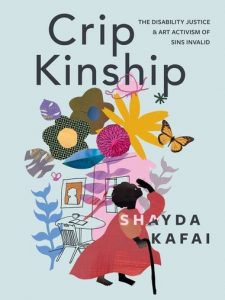Amazon Affiliate Link | Bookshop.org Affiliate Link
My first introduction to disability justice was reading Care Work: Dreaming Disability Justice by Leah Lakshmi Piepzna-Samarasinha, which was one of the most powerful and thought-provoking books I’ve ever read, so when I saw that Arsenal Pulp had released another book on disability justice, I knew I had to read it. Disability justice is disability activism that centres queer and trans Black, indigenous, and people of colour. It advocated for leadership from the most impacted, and it views ableism as being interconnected with other systems of oppression, including racism, capitalism, transphobia, anti-fatness, and more.
This is a history of Sins Invalid, a disability justice performance project founded in 2006 in San Francisco. It explains how they got started, but more than just recounting, it explores the ideas behind Sins Invalid and why it became such an important outlet for people. It discusses how the mainstream disability rights movement as well as disability studies as an academic framework centre white disabled activists.
Crip Kinship reclaims beauty and sexuality for queer, trans, disabled POC and Indigenous bodies: “Beauty here becomes the limp, it becomes burned glossy skin, and abundant drool. Beauty becomes Mad minds rapid loving and stimming hands. It is the survival magic of all our bodyminds doing beauty by blurring boundaries.” Sins Invalid is “transgressing the ableist assumptions that disabled bodyminds cannot: we cannot dance, we cannot speak through movement, we cannot express beauty in our bodyminds. Instead, participants learn that these limitations on movement and dance are not necessarily coming from their bodyminds, but rather from ableism’s finite imagination of who can dance and of whose movement is deemed beautiful.”
It outlines a different way of organizing as well as a different lens to examine politics. Politics not as abstract, but as material conditions that are life or death right now, and require support and accessibility. Crip Kinship invites readers to imagine what it would look like if we considered all people’s needs and came up with the solution most accessible to all, knowing that some needs will conflict, and that the process will be messy and need constant re-examining and adaption:
“[Y]ou know you’re doing [Disability Justice] because people will show up late, someone will vomit, someone will have a panic attack, and nothing will happen on time because the ramp is broken on the supposedly ‘accessible’ building … Disability Justice, when it’s really happening, is too messy and wild to really fit into traditional movement and nonprofit industrial complex structures, because out bodies and minds are too wild to fit into those structures.”
This is part history, part manifesto, bringing in so many different voices. I especially liked a chapter that discussed how Sins Invalid reclaims beauty for disabled bodyminds, but also gives space for another disability justice perspective that beauty is an unsalvageable concept based in restriction and oppression, and that it is more freeing to reclaim Ugly as a concept.
If all of these concepts and terms seem overwhelming, they are defined in end notes in the book, which is very helpful.
My only complaint was that I would have liked to see more about the people and relationships behind Sins Invalid: we see a few glimpses of conversations had at the beginning, but most of the focus was on the big picture. I would have liked some behind the scenes of what that messy process of disability justice looks like in practice, with creating this organization and keeping it running all these years. I also wanted more description of the actual performances, because what is included is incredible, but I now see that there are clips to watch for free and some documentaries for purchase on the website, so I look forward to watch those!
In fact, I am left with a long reading (and watching and listening) list of books, articles, podcasts, and videos I noted that I wanted to follow up on, and those are only a few of the resources and references collected in this book. The references given are carefully selected, highlighting disabled queer, trans, BIPOC voices, whether that’s in their published books, personal interviews, blog posts, or other formats. This makes for a great jumping off point to follow up these ideas.
I highly, highly recommend this and Care Work to anyone and everyone. It left me with a lot to think about, and I can’t wait to learn more.

